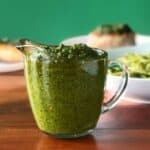Arugula Pesto with Pistachios
This arugula pesto is a fresh, luscious sauce that goes with just about everything! Dollop it on pasta, burgers, chicken, seafood, eggs, vegetables, sandwiches, soup and more. Plus it's so fast and easy to make you'll be whipping it up every chance you get.
Servings: 4 servings
Calories: 351kcal
Ingredients
- 1 medium garlic clove
- 4 cups packed (not too tightly but not loosely) arugula or baby arugula
- ½ cup freshly grated Parmesan cheese
- ⅓ cup shelled pistachios
- ¼ teaspoon fine sea salt
- freshly ground black pepper
- ½ cup extra virgin olive oil (or more or less, depending on your preference)
Instructions
- Use the flat side of the knife to press down on the garlic cloves until the peel cracks, then remove and discard the peel.
- Add the garlic, arugula, cheese, pistachios and a few grinds of black pepper to a large food processor or high-speedo blender. If using unsalted pistachios, add the ¼ teaspoon salt now. If using salted pistachios, wait until you taste the pesto at the end. Pulse a few times to create a paste.
- While blending/pulsing, slowly drizzle in the olive oil through the feed tube/lid insert, until the pesto is your preferred consistency. You may have to stop at some point to scrape down the sides of the bowl.
- Taste and add more salt and pepper, if necessary. (If you do, stir these in by hand. You don't want to process the pesto any longer than necessary.) If your pesto tastes bitter, see the notes below.Recipe yields approx. 1 cup.
Notes
Storage
You can store pesto in the fridge for up to 3 days before it starts to lose flavor. Store it in glass jars and add a thin layer of olive oil on top (this will create a "seal" to keep out air, which will help slow down the oxidization process which is what makes pesto lose its color and flavor).
Can you freeze pesto?
Yep! My favorite way is to freeze it in ice cube trays. Once frozen, add the cubes to a freezer-safe baggie or container. You can thaw overnight in the fridge or add directly to your recipe, depending on how you're using it (see serving ideas below).
Why is my pesto bitter?
Sometimes pesto, whether classic or this arugula version, can taste bitter. This can happen for a couple reasons:
- The herbs or leafy greens weren't as fresh as they appeared.
- Olive oil can sometimes have a bitter note to it, especially if it's old. Use the best, freshest olive oil you can.
- Arugula's peppery flavor can sometimes edge into bitter territory. If you think your arugula is the culprit, add more of the fats to balance and round out the flavor: nuts, cheese and/or olive oil.
- You blended it too long in the processor or blender. As you blend it, the speed of the blades is so fast that it can end up almost heating up the pesto which can kill its freshness. Don't blend any longer than you have to to get the consistency you want.
- Replace some of the arugula with basil, mint, parsley or baby kale.
- Replace the pistachios with any nuts of your choice, like pine nuts, almonds, walnuts, cashews or hazelnuts.
- Replace the Parmesan with a similar dry, salty cheese like Pecorino or Manchego.
- Add the zest of half a lemon for a burst of brightness.
Nutrition
Calories: 351kcal | Carbohydrates: 4g | Protein: 7g | Fat: 35g | Saturated Fat: 6g | Polyunsaturated Fat: 4g | Monounsaturated Fat: 23g | Cholesterol: 9mg | Sodium: 352mg | Potassium: 194mg | Fiber: 1g | Sugar: 1g | Vitamin A: 615IU | Vitamin C: 4mg | Calcium: 192mg | Iron: 1mg
